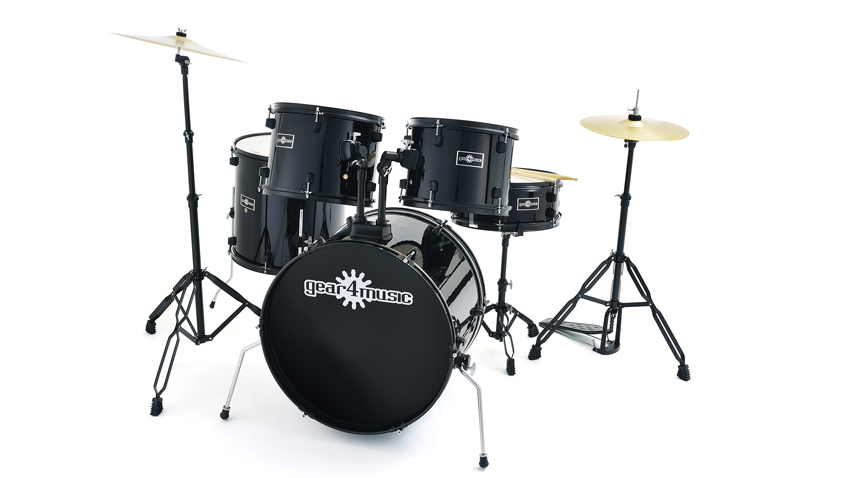MusicRadar Verdict
Though you might also want to invest in a course of drum lessons and perhaps some sound-dampening (to retain parental sanity and maintain a good relationship with the neighbours), this kit represents great value for money and gives you everything that's required to get up and drumming.
Pros
- +
Acceptable sound. Easy to tune. Stable.
Cons
- -
Thin heads. Cymbals aren't up to the standard of the rest of the kit.
MusicRadar's got your back
Gear4Music's BDK-1 set up is just one of a large selection own-branded acoustic drum kits pitched at the first-time buyer. From the tot-sized 3-piece for under £60 to the larger, grown-up sized 5-piece GD-51 kit at that comes in at a snippet under £350, the range is as affordable as it is comprehensive. While these kits will appeal to a parent on a tight-budget, the decision on which set to choose will largely come down to the physical size of the model in question.
In our experience, the first time a youngster sits behind a full drum kit there are the usual tentative strikes. Then, when they feel comfortable, they begin to hit harder, seemingly muttering a kind of 'harder, faster, harder, faster!' mantra as they do so. This being the case, the drums will have to be up to the job of taking a pummelling. However, some starter sets have a reputation for being flimsy and not able to handle the likely 'onslaught', so we were particularly interested to see if this set will be safe in the hands of a budding basher.
Build
Like many kits of this ilk, everything comes packaged in one large and bulky box. This weighs in at just under 40kg, so it's heavy, too! Contained in this box is a whole 5-piece set-up including three tom-toms, snare drum, bass drum, cymbal stand, hi-hat stand, drum stool, bass drum pedal, drum stool, pair of 14" hi-hat cymbals, crash\ride cymbal, a pair of 5B sticks and a full set of drum heads, completing the ensemble.
With the exception of the snare, the drums have bare shells with the heads removed and are to be found within the large box amongst their own packaging. Once freshly delivered to your door by the courier, it's up to the proud new owner to attach the heads and a variety ancillary parts such as bass drum spurs, floor tom legs and, of course, the hardware.
Each drum shell is constructed from plies of "high-grade" basswood - a fast-growing, abundant tree which provides a cost-effective material for many starter kits. It has a straight but non-descript grain and is a softer, less dense material than the more costly maple or birch, providing a mellow tone.
The 22" bass drum has pressed steel claws, shaped for strength, and a set of spurs which appear robust with knurled portions which aid grip into the clamps. Each spur has rubber feet which retract to reveal spikes, ensuring good bass drum stability and grip on most surfaces.
While the supplied single-ply heads should help breathe a little extra 'spark' into the soft sounding shells, these are worryingly thin and will, no doubt, quickly need to be replaced. The basic set of cymbals has dummy 'lathe' lines and all the appearance of brass or bronze models (albeit a bit dull in comparison). However, these are made from steel, a material chosen for durability and economics rather than its sonic properties.
Want all the hottest music and gear news, reviews, deals, features and more, direct to your inbox? Sign up here.
Hands on
Before either one of the supplied 5B sticks heads across it, the kit requires some first-time assembly. Not only is this essential (and can be enjoyable too!), it's a feet-first process of drum ownership which rapidly helps a player become familiar with the various kit components.
Though G4M provides full instructions, having to fit each of the new heads still takes a good few hours. Applying the correct tension (drum tuning), is then required to get the best sound possible from the kit.
Like the rest of the kit, the snare has the absolute bare minimum of tension bolts which (due to the distance between each lug), has the rather odd advantage of making any tension differential seemingly easier to detect.
Once fairly evenly tuned and cranked up, the sound is acceptable. At times, though, the snare rattle can drive you to distraction. Tuning the rest of the kit is a quick process thanks to the surprisingly smooth tuning components of each lug and tuning bolt.
Strategically placed dampening (courtesy of Moongel, pieces of felt and other methods), is necessary to focus the kit and show off its potential. Just one or two strikes of the cymbals proves that these are no match for the rest of the kit - they are, however, quite resilient and this could be of particular importance here. With the aid of the double-braced hardware and robust kick spurs the kit feels extremely stable and capable of handling some hefty strikes.
